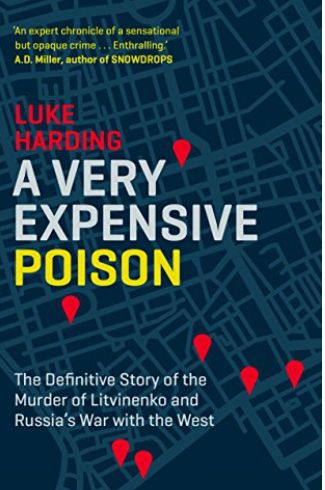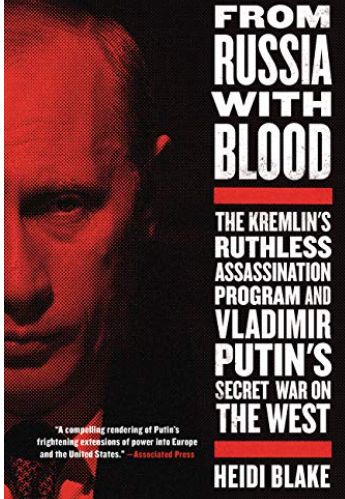By
Eric Vandenbroeck and co-workers
Russian Intelligence
It is
clear that Russia has
developed a deep understanding of how Americans think, what motivates them,
their interests, and how open and democratic societies work. This enables
Russia to pursue its exceptionally well-defined targeting strategy against the
United States. Hence Russian intelligence and security services are
extraordinarily well prepared to counter U.S. interests and advance Russia’s.
In an earlier article, we suggested that
opposing concepts of trust explain why trying to normalize relations with
Russia has failed. Episodic and superficial easing of tensions has occurred. They can cooperate with Russia when mutual
interests coincide.
This said, Russia has one of the world’s most
preeminent intelligence services. Putin’s top three intel agencies are the
Foreign Intelligence Service (Sluzhba Vneshney Razvedki, or SVR),
the Main Intelligence Directorate of the General Staff, or military
intelligence (Glavnoye Razvedovatel’noye
Upravleniye, or GRU), and the Federal Security
Service, or domestic spying (Federal’naya Sluzhba Bezopasnosti, or FSB).
These agencies are only rough counterparts to the U.S. Central Intelligence
Agency (CIA), the Defense Intelligence Agency (DIA), and the Federal Bureau of
Investigation (FBI). They've combined the Soviet predecessor, Committee on
State Security (Komitet Gosudarstvennoy Bezopasnosti,
or KGB), Putin’s alma mater, traced its origins to the All-Russian
Extraordinary Commission, or Cheka (based on the Russian acronym ChK), which Vladimir Lenin established shortly
after the Bolshevik Revolution of 1917.
Cheka’s initial
mission was primarily domestic, to ensure the “dictatorship
of the proletariat” of the young Soviet State by rooting out the “enemies
of the people.” For allied forces, a Germany freed from its eastern front
now became an extreme danger for the western front. Thus allied spies were
asked to find those Russian groups that were willing to open a new eastern
front of which there were a number who were upset and in total disagreement
with the Boljewists signing
the treaties of Brest-Litovsk which also included the so-called
left-wing social revolutionaries who now went as far s
to murder the German ambassador to the dismay of the Boljewists
and join the Boljewist opposition. When in disagreement with the
Bolsheviks this by default was perceived as
a counter-revolution.
Violence and
executions were Cheka’s main instruments, advocated political as justifiable
and necessary by the chief of Cheka, Polish-born revolutionary Felix
Dzerzhinsky, Lenin, and his successor Joseph Stalin. Cheka operatives called
themselves Chekists (Chekisty), the term that came to
refer to Soviet intelligence services in general, including the KGB, invoking
the terrifying images of the Red Terror. The Chekists
carried out the repressions by arresting people suspected of political
subversion and sending them to labor camps or executing them without trial.
They usually took their victims in the middle of the night without explanation.
The families never heard from their loved ones again.
Nowadays, the Russian
security and intelligence services, including their former members, who
predominantly occupy key positions in Putin’s government as well as in
strategic industries like oil and gas, are referred to as siloviki (“men
of force and power”). Siloviki have largely
inherited Chekists’ operational methods but have refined the “special
tradecraft” of eliminating the opposition. Instead of executions by a shot in
the back of the head, they use a less messy method: poisonings.
From Stalin to Putin
According to the following four books, Stalin’s legacy
continued in growing science and substructure of labs dedicated to developing
untraceable poisons and new bioweapons. Stalin’s labs live today in Putin’s
Russia, which dispatched operatives to poison Ukrainian leader
Viktor Yushchenko, ex-Russian agents in the UK, and Russian opposition
leader Alexei Navalny. His labs and their technology are shared with other
Communist states. Laboratories of the SVR (headquartered in Yasenevo near Moscow) were responsible for creating
biological and toxin weapons for clandestine operations in the West.
According to Insider, some of the other Putin critics
who've died are Alexander Litvinenko, Anna Politkovskaya,
Natalia Estemirova, Stanislav Markelov, and
Anastasia Baburova, Boris Nemtsov, Boris Berezovsky,
Paul Klebnikov, Sergei Yushenkov, Sergei
and Yulia Skripal, Mikhail Lesi.
In 1925-30, Stalin
created an all-star team of assassins in Paris. They were the most influential
and capable group of assassins; they were commonly called “Yasha’s Group,”
after their legendary founder Yakov Serebryansky, Yasha. The Yasha Ring
centered in Paris had used a variety of poisons from the
so-called Laboratory One.




Initially, the poison
and bioweapon section may have been authorized by Lenin and Stalin as early as
1921. The lab, which changed names many times, was initially called the
Special Cabinet but eventually switched to Laboratory One.1
The ongoing questions
surrounding Lenin’s death show why poisoning was such an effective way to kill.
In his 1994 book, Special Tasks, Pavel Sudoplatov, a Russian KGB agent,
discusses his participation in four “staged” natural deaths using poisons and
infections from Laboratory One in the 1930s and 1940s.2
A Soviet KGB
defector, Walter Krivitsky, remarked that “any idiot can commit a murder,
but it takes a true artist to stage a natural death.” 3 Krivitsky, who
predicted his murder by the KGB, was found dead shortly after that with a
bullet in his temple and a suicide note, no doubt dictated by the KGB.4
A secret study in
1963 by the CIA for the Warren Commission, only declassified and released in
1993, concluded that there were many natural deaths staged by the KGB in
Western Europe, particularly of targeted Russian émigrés.5
Had the West been
paying attention, details of the poison lab were revealed in the 1938 “Trial
of the Twenty-One,” where three doctors involved in the poison lab were
accused of conspiring to poison high-level Communists. Some had poisoned Soviet
leaders at Stalin’s direction but presented these
crimes in the trial as rogue operations under pressure.6
In the late 1930s, as
he would again in the early 1950s, Stalin determined to bury his crimes by
sealing the lips of his accomplices. He liquidated the entire top echelon of
the security organs and Lab One in 1938 virtually, moving in new executioners
and scientists to run the lab. Only at the 1938 show trials of top KGB
officials did the first information of any kind on the ultra-secret poison lab
become known.7 KGB officials were accused of using
poisons, a certainly true charge, but they were not allowed to testify that it
was at Stalin’s direction.8
Putin's reference to the Yasha Ring
When Vladimir Putin
gave an address to mark the founding of the illegal intelligence service in
1922, he read out a roll-call of legendary Soviet and Russian agents. The first
name on Putin’s list was the Yakov mentioned above, Serebryansky founder of the Yasha Ring.
Once-popular Putin
ruled through terror and the promise of conquering weaker nations.9 With
Putin’s election in 2000, contra to Yeltsin's initial hope when he called
Clinton to inform him about Putin and added I am also sure
that he is a democrat, the
young Russian democracy began slowly to die.10
The Soviet Cheka, in
turn, operated on the same principles as the czarist Okhrana (The Guard), or
secret police, who used provocations and penetrations of various groups to
uncover multiple plots to overthrow or assassinate the czar. Professional
revolutionaries, therefore, conducted their activities “underground,” using
false identities or pseudonyms. For example, Lenin’s real name was Vladimir
Ilyich Ul’yanov, and Stalin’s was Joseph Vissarionovich Dzhugashvili. A
combination of secrecy and deception captured by the Russian term konspiratsiya were essential components of the operational
security that the Chekists practiced. Soviet and later Russian intelligence
services demanded strict adherence to the rules of konspiratsiya
from its operatives prioritized the security of its secrets and operations,
making it very difficult to identify and break into. A 2006 intelligence
tradecraft manual describes one of the missions of konspiratsiya
as creating “a false impression with the adversary about an operation conducted
by an opposing intelligence service.” This is achieved by “influencing
the adversary’s mindset and psychology through dezinformatsiya.” This can be
possible only by thoroughly studying the adversary and the doctrine of its
intelligence and counterintelligence services in advance. In other words, one
must “feel the adversary.”
A startling example
of Moscow’s spy-craft trickery and Washington’s gullibility was the
construction of a new U.S. Embassy in Moscow in the 1980s. The Soviets had
finally agreed to let the Americans move from the run-down pre-Bolshevik
embassy, which they had constantly bombarded with electronic attacks, to a new
building. The Soviet government convinced Americans to let them “help” build
the new building, using Soviet construction workers and Soviet-made
construction materials. Despite being warned by a Soviet defector soon after
the construction began that the new embassy building would be riddled with
listening devices, U.S. government experts arrogantly thought that there was
nothing that the Soviets would implant in the building that American technicians
could not disable. 9 years and millions of dollars later, it became clear that
they were disastrously wrong.
After the Soviet
bugging of the new U.S. Embassy became public in 1986, followed by a series of
congressional investigations, President Reagan 1988 ordered the building torn
down.
It turned out to be
impossible to “debug” the embassy because the Soviets embedded the sensors in
the very structure of the building. Columns, beams, and rods made from
“specially” pre-cast concrete formed a giant antenna. Stunned by the
sophistication of the construction, which housed a power source that
purportedly could last a hundred years, the American technicians didn’t wholly
understand either the technology or the design used for the interception of
U.S. Embassy communications.
According to the same
defector, this surveillance system included numerous features. In addition to
the technology embedded in the structure of the building, underground tunnels
ran to the foundation walls, and microphones were installed within the furniture
and office equipment, which would allow the Russians to have both audio and
video of everything that was going on inside the American Embassy. The
Russians, who are culturally predisposed to expect things to go wrong, are
known to place a premium on redundancy. If one part of the system goes down or
doesn’t provide the visibility of U.S. secrets that Moscow wants, another part
fills in the gaps. They use the same approach when building their communication
systems, which they expect the Americans to work hard at attempting to breach.
The U.S. government
ended up removing the top four floors that contained the SCIFs (sensitive
compartmented information rooms), where the most sensitive areas of the embassy
would be located, and replacing them with the new four floors built out of
American construction materials by hiring private contractors and using
American Navy personnel. 13 In 1987, a Senate committee described the Soviet
spy-craft as “the most massive, sophisticated, and skillfully executed bugging
operation in history.”
This was not the
first time the U.S. government was fooled by microphones provided by Soviet
intelligence. In 1952, U.S. technical security personnel uncovered a listening
device hidden in the wooden replica of the Great Seal of the United States. The
Seal was hanging right over U.S. Ambassador George Kennan’s desk at his office
in the embassy. It was gifted by the Soviets to U.S. government officials at
the end of World War II and was transmitting secrets to the Kremlin until it
was discovered years later during an electronic “sweep.” In the 1960s, in
several intelligence operations, the Soviets daringly tried and sometimes
succeeded in planting microphones in Congress.
The U.S. government
is slow to learn from its mistake of employing Soviet and Russian personnel in
U.S. Embassy offices in Russia. For example in January
2017, a female Russian national was fired from the U.S. Embassy in Moscow based
on suspicion of espionage. Recruited by the U.S. Secret Service, she worked at
the embassy for ten years. She had access to highly confidential electronic
communications, including the schedules of the U.S. president and vice
president. The woman regularly met with an agent from FSB, Russia’s main
domestic security and intelligence agency.
Russia uses its
embassies in the United States as the base of intelligence operations against
America and Americans. Russian intelligence operatives under official cover
work out of the embassy-based residency (Rezidentura),
posing as diplomats. They collect political, military, economic, and scientific
intelligence, spot and recruit Americans who would spy for Russia, and run
technical collection operations. The chief of the Rezidentura
is called the “Resident,” the equivalent of the American chief of station at a
U.S. Embassy. The Russian Embassy compound in Washington, D.C., and Russia uses
its embassies in the United States as the base of intelligence operations
against America and Americans. Russian intelligence operatives under official
cover work out of the embassy-based residency (Rezidentura),
posing as diplomats. They collect political, military, economic, and scientific
intelligence, spot and recruit Americans who would spy for Russia, and run
technical collection operations. The chief of the Rezidentura
is called the “Resident,” the equivalent of the American chief of station at a
U.S. Embassy. The Russian Embassy compound in Washington, D.C., and consulates
in New York and San Francisco are all located at high points of elevation to
enable interception of U.S. communications by arrays of antennae and other
electronic equipment perched on the rooftops.
The closure of
several Russian government facilities in the United States is just one example
of the significant tension in U.S.-Russian relations that began to spiral after
Putin annexed Ukraine’s Crimea. Having finally recognized the failure of the
“reset” policy with the Kremlin, the Obama administration imposed economic
sanctions on select Russian entities and individuals, which resulted in a chain
reaction between Washington and Moscow of reducing one another’s “diplomatic”
presence at embassies and consulates. Sanctions and fewer “diplomats,”
undoubtedly justified and necessary, also undermined both countries.
Putin’s strategy
against America hinges on Russia’s ability to develop a deep understanding of
the strengths and weaknesses of American society to identify vulnerabilities to
exploit.
To help gain detailed
knowledge and understanding of how American society functions, how we think,
and what makes us tick, the Russian intelligence services employ HUMINT
tradecraft with minor exceptions, such as Israeli intelligence - unique to
Russia and earlier the USSR. The Russians insert what are called “illegals” (nelegaly), or deep-cover intelligence officers, within the
adversary’s society who pose as the citizens of that country or a different
country, but not Russia. Unlike their “official cover” counterparts, the
illegals don’t have the benefit of diplomatic immunity, which would protect
them in the event of being exposed. They know that if their cover is blown and
they get arrested by the law enforcement of their adopted “homeland,” they will
go to prison.
Illegals spend years
and even decades in the target country, including the United States, living
like normal Americans or other host country nationals. They obtain jobs, go to
universities, build relationships with people who could be valuable to Russian
intelligence, and sometimes even raise children who have no idea their parents
are not who they think they are. These deep-cover officers take orders from
Moscow, using clandestine communications devices and covert Russian
intelligence agents. The illegals build and reinforce their cover - sometimes
for many years without being tasked with any operational assignments - to fit
in well in the American culture while learning about the nation’s psyche. Their
ultimate purpose is to help their true homeland take on, destabilize, and
defeat “the main adversary” by stratagem.
The Russian
intelligence tradecraft sending deep-cover officers “behind the enemy lines”
dates to the Cheka. The newly established Soviet state was initially not
recognized diplomatically by the West, including the United States, leaving
Soviet intelligence without the traditional option of operating out of
embassies and consulates.
Putin’s current
strategy is to prevent the former Soviet Union countries from meeting the NATO
membership criteria of having territorial integrity and being free of an
ongoing conflict, as is now with Ukraine.
As George Kennan
pointed out, the Russians, fearing our intentions, are fanatical in their
belief that “with the [United States], there can be no permanent, peaceful
coexistence.” Therefore, it is “necessary that the internal harmony of our
society be disrupted, our traditional way of life be destroyed, the
international authority of our state be broken” for the Russians to feel
secure.
Continued in Part Two
For updates click hompage here